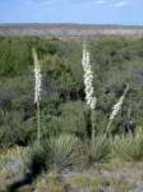

Genus: Yucca
Species: elata
Parts Used:

Imagine bumping down a dusty desert road, looking at the wide open land stretching out in all directions. Along the sands are plants, some squatting in the burning sun, others standing tall, watching the sky for a chance of rain. As you speed along, you notice an exotic looking plant growing in the mesas and washes of the desert. You turn to your driver and inquire about the plant. The driver tells you that it is the Soaptree Yucca.
The Soaptree Yucca is commonly found n the Sonora and Chihuahua deserts, Texas, New Mexico, Arizona and northern Mexico. Thanks to its exotic look, the plant has been introduced to eastern soil, and can be found growing in climates that are not just hot and dry like the desert.
The Soaptree Yucca is a tall 10-18 foot plant with palm treelike leaves. These leaves are at the base of the plant. They are very similar to those of a palm tree in the respect that the green leaves of the Soaptree Yucca are long and triangular shaped and are not wide. The stalk that shoots up from the leaves is a twig-thin stalk with small white flowers growing at the top. The plant's fruit is also on the stalk and is a brown capsule until the summer, when it splits into three sections that contain black seeds.
Maybe you are wondering why the plant is call the "Soaptree" Yucca. There is a logical reason. Inside the roots and trunk of the plant is a soapy substance. This substance was commonly used as a substitute for soap. In a drought, ranchers use the plant as an emergency food supply for their cattle. In the days when Native Americans dwelled in the deserts, the fiber of the Soaptree Yucca's leaves were used to weave baskets. This plant gave them a head start to finding enough food, because the Native Americans most likely used the baskets to collect food. The Yucca is also used for decoration in many American gardens. So this plant's leaves, roots, trunk and stalk have been useful to humans since the time of the Native Americans.
The Yucca is a very climate compatible plant because if you look hard you can find it almost anywhere.
by Simone Mc. 2000.
Bibliography:
Posell, Elsa. (1982) New True Book: Deserts, Chicago., IL: The Children's Press
Taylor, Barbara. (1992) Desert Life., New York City, NY: DK Publishing Inc.
"Desert Plants and Wildflowers." http://www.desertUSA.com (6/6/00)